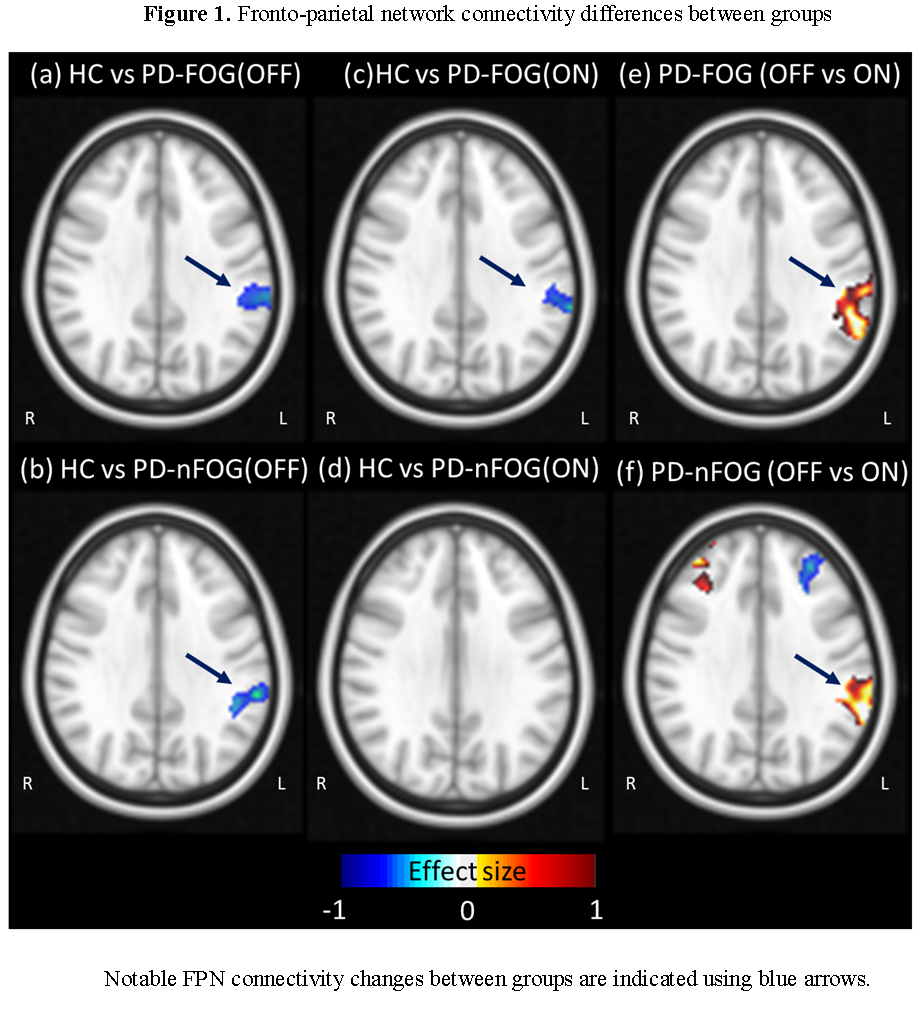Session Information
Date: Monday, October 8, 2018
Session Title: Parkinson's Disease: Neuroimaging And Neurophysiology
Session Time: 1:15pm-2:45pm
Location: Hall 3FG
Objective: To investigate the effect of levodopa on fronto-parietal network (FPN) functional connectivity (FC) in Parkinson’s disease patients with (PD-FOG) and without freezing of gait (PD-nFOG).
Background: Executive dysfunction plays a role in PD-FOG, and neuroimaging studies have revealed that PD-FOG is associated with impaired functional connectivity within the FPN [1]. PD-FOG may respond to levodopa, however the effects of levodopa on the FPN in PD-FOG have yet to be investigated.
Methods: Preliminary analyses were performed using 7 PD-FOG, 4 PD-nFOG and 8 healthy controls (HCs) from the Center for Neurodegeneration and Translational Neuroscience (Table 1). All participants underwent resting-state functional magnetic resonance imaging (fMRI) using a 3T scanner. PD-FOG and PD-nFOG patients were scanned during the levodopa OFF and ON states. Preprocessed resting-state fMRI data from all groups were input to a spatial independent component analysis (ICA) and the FPN consistent with previous report [2] was identified. Between group comparisons (HC vs PD-FOG (OFF and ON) and HC vs PD-nFOG (OFF and ON)), as well as OFF versus ON comparisons for both PD groups were performed.
Results: (a) OFF state: Compared to HC, both PD-FOG and PD-nFOG showed greater connectivity in the supramarginal gyrus (SMG) (Fig. 1a and 1b). (b) ON state: PD-FOG continued to show greater connectivity in the SMG compared to HC, but to a lesser degree than in the OFF state (Fig. 1c). PD-nFOG did not show any significant differences compared to HC in the ON state. (c) OFF versus ON: Functional connectivity of the SMG reduced in both PD-FOG and PD-nFOG with levodopa, but to a greater degree in PD-nFOG. There was altered connectivity of the Medial Frontal Gyrus bilaterally in the PD-nFOG group. (Fig. 1e and Fig. 1f)
Conclusions: We observed greater connectivity of the SMG in both groups of PD patients in the OFF state compared to HCs. Hyperconnectivity in both PD groups was mitigated by levodopa. However, although levodopa reduced the hyperconnectvity in both PD groups, it had a greater effect in PD-nFOG than PD-FOG. Our findings suggest that altered functional connectivity within the FPN network improves somewhat in PD-FOG with levodopa, but not to the same degree as in PD-nFOG.
References: [1] Tessitore, A., Amboni, M., Esposito, F., Russo, A., Picillo, M., Marcuccio, L., Pellecchia, MT, Vitale, C., Cirillo, M., Tedeschi, G., Barone, P. (2012) Resting-state brain connectivity in patients with Parkinson’s disease and freezing of gait. Parkinsonism & Related Disorders, 18(6), pg. 781-787. https://doi.org/10.1016/j.parkreldis.2012.03.018. [2] Beckmann, C., Mackay, C., Filippini, N., Smith, S., (2009). Group comparison of resting state FMRI data using multi-subject ICA and dual regression. NeuroImage 47, S148. https://doi.org/10.1016/S1053-8119(09)71511-3.
To cite this abstract in AMA style:
B. Bluett, E. Bayram, S. Banks, X. Zhuang, V. Mishra, Z. Yang, C. Bird, D. Cordes, Z. Mari, I. Litvan, K. Sreenivasan. Effect of levodopa on fronto-parietal network connectivity in freezing of gait in Parkinson’s disease [abstract]. Mov Disord. 2018; 33 (suppl 2). https://www.mdsabstracts.org/abstract/effect-of-levodopa-on-fronto-parietal-network-connectivity-in-freezing-of-gait-in-parkinsons-disease/. Accessed January 7, 2026.« Back to 2018 International Congress
MDS Abstracts - https://www.mdsabstracts.org/abstract/effect-of-levodopa-on-fronto-parietal-network-connectivity-in-freezing-of-gait-in-parkinsons-disease/


